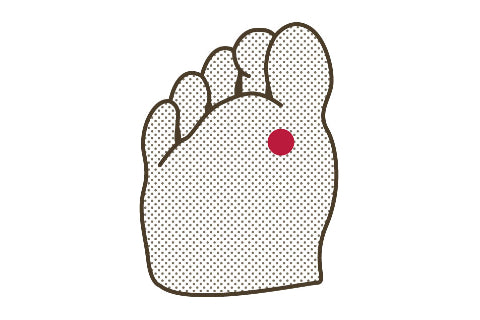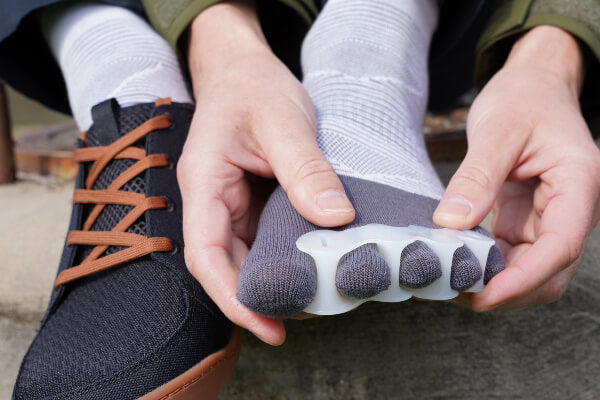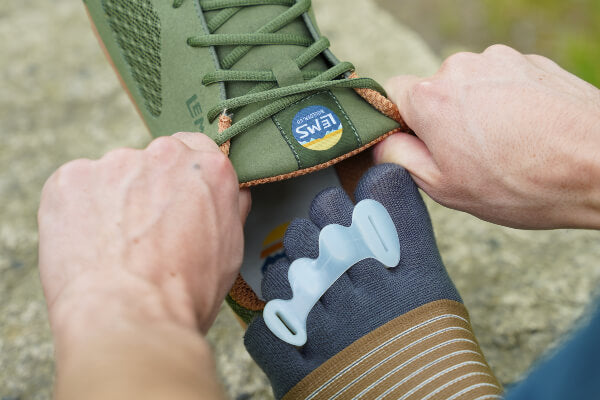
Definition
Plantar Fibroma: A fibrous knot or nodule embedded in the plantar fascia, in the arch of the foot.
General Info
A plantar fibroma is a knot or nodule of fibrous tissue that develops in the medial longitudinal foot arch. This nodule grows within the plantar fascia—a strong band of connective tissue on the underside of the foot that runs from the heel to the toes. Plantar fibromas can develop in one or both feet, are noncancerous (i.e., benign), and typically will not resolve without appropriate treatment. Though a number of theories have been proposed, a definitive cause for this foot problem has not been identified or agreed upon by researchers or practitioners.
Plantar fibromas, unlike plantar warts (which grow on the skin), grow within the thick, fibrous connective tissue of the plantar fascia. Plantar fibromas are slow-growing masses and usually themselves do not cause pain. However, as they become larger, they may put pressure on sensitive structures (such as nerves and blood vessels) within the foot, which can make weight-bearing activities (e.g., walking, standing, running) for prolonged periods quite painful. They can also cause gait changes that put abnormal stress on the body’s joints and soft tissues.
This common growth is usually a solitary nodule, though multiple nodules are possible in the same foot. The mid-arch region of the foot is the most common location for plantar fibromas to develop, though they can appear anywhere along the underside of the foot. Plantar fibromas can occur in people of any age, though they are most common in children. Plantar fibromas, though not life-threatening tumors, can be profoundly uncomfortable, reduce mobility, and impair a person’s ability to wear shoes.
Signs & Symptoms
Plantar fibromas appear as one or more (painful or painless) lumps on the bottom of the foot and are firm to the touch. This lump can stay the same size or grow over time (sometimes to the size of a golf ball!), or more nodules may appear. Walking and wearing shoes can cause pain or discomfort. To help diagnose the problem, a foot care professional will often press on the lump, and this may generate pain that extends to the toes. An MRI or biopsy can also help confirm or rule out a plantar fibroma.
Possible Causes
Researchers and physicians are still unsure about the underlying cause(s) of plantar fibromas, though many believe there is a genetic component to this problem, as some people are predisposed to fibrotic diseases and an overdevelopment of connective tissue. Other possible contributing factors include:
-
Improper Footwear: Footwear that contains heel elevation and toe spring stretches the plantar fascia and leads to weakness in this tissue. Fibromas may develop in response to a loss of plantar fascia integrity, foot structure imbalances, or point pressure caused by the above-mentioned shoe features.
-
Trauma: Damage to the plantar fascia may lead to a plantar fibroma, though this factor is contested by some. It’s thought that the formation of excess tissue may be a robust healing response after overuse or traumatic injuries, such as a puncture wound.
-
Certain Health Problems: Individuals who have certain pre-existing conditions (such as diabetes, epilepsy, liver disease, and thyroid problems) appear more likely to develop plantar fibromas.
-
Certain Medications: Some medications may increase the likelihood of a plantar fibroma, especially when taken after plantar fascia trauma. Such medications include beta-blockers and anti-seizure drugs.
-
Other Factors: Other factors that may play a role in the development of plantar fibromas include alcoholism, age, and gender.
Helpful Strategies
Conservative (i.e, nonsurgical) care measures can help reduce the pain and discomfort of a plantar fibroma, though they will not make the lump disappear. Some of the most common non-surgical approaches to treating plantar fibromas include:
- Stretching exercises
- A change in footwear to help redistribute bodyweight more appropriately
- Physical therapy modalities that deliver anti-inflammatory substances directly into the fibroma
Surgery to remove the plantar fibroma is commonly performed, especially if non-surgical methods fail to manage the pain or discomfort, though possible problems associated with surgery include:
- The onset of hammertoes
- A high incidence of recurrence
- A flattening of the main foot arch

WANT TO IMPROVE YOUR FOOT HEALTH?
Let the team at Natural Footgear help you! Subscribe to our newsletter for the latest offers and helpful info, and sign up for our FREE email courses on various topics and foot health conditions.
Sign Up →
Want to Improve Your Foot Health?
We are here to help you every step of the way. Get our newsletter for the latest offers and helpful info, and sign up for our FREE email courses on various topics and conditions, including bunions, hammertoes, neuromas, plantar fasciosis, shin splints, ingrown toenails, and more.
Sign Up →
 Plantar warts, also called verruca plantaris, are a buildup of skin on the bottom of the feet. Plantar warts are benign skin growths caused by the human papillomavirus, or HPV. This virus enters the body through small cuts or breaks in the skin of the feet. The buildup of thick, irregular skin on the bottom of the feet that characterizes plantar warts is sometimes confused with calluses, due to their...
Read more
Plantar warts, also called verruca plantaris, are a buildup of skin on the bottom of the feet. Plantar warts are benign skin growths caused by the human papillomavirus, or HPV. This virus enters the body through small cuts or breaks in the skin of the feet. The buildup of thick, irregular skin on the bottom of the feet that characterizes plantar warts is sometimes confused with calluses, due to their...
Read more






Are there any specific shoes that are good for plantar fibromas? My fibromas are located in the front portion of my heels (on the inside of each foot).
Hi, LH,
Thank you for your comment! The causes of plantar fibromas are varied, but the prolonged use of conventional footwear is one possible common underlying cause of this problem.
Shoes with toe spring and heel elevation stretch your plantar fascia, which can lead to tissue weaknesses that ultimately result in fibromas. Redistributing bodyweight over the entire foot through the use of foot-healthy footwear often yields positive results. All of the shoes we offer on our site meet our Natural Footgear Certified specifications, so our recommendations would be based on the type of activities you’d be engaging in. If you need additional cushioning to deal with contact pain, we’d recommend our Altra options, as they have the thickest soles of any of the footwear we offer. You can find a link to all our footwear offerings below:
www.naturalfootgear.com/collections/mens-shoes
www.naturalfootgear.com/collections/womens-shoes
I hope this information is helpful. If you have any further questions, please do let us know!
Kind Regards,
Andrew Potter
I’m a full-time waiter of 40 years who has developed two fibromas in my right foot and one in my left foot. I am currently awaiting orthotics. My gut instinct tells me that the podiatrist I saw is not that knowledgeable about how to help me, or that he even really cares. He didn’t seem to think that any particular shoe would help me while I wait for orthotics for over 6 weeks (and while I continue to wait tables full-time with significant pain and plantar fascia symptoms).
Hi, Tim,
Thank you for your comment. I’m really sorry to hear about your foot pain; I hope that you experience a resolution of your foot discomfort very quickly and are able to continue working in a pain-free state. Please let us know if there is anything we can do to assist.
Kind regards,
Marty Hughes, DC
I have three fibromas in the arch of my foot. They are tender. I have high arches and overpronate. What shoe do I need? Do I need arch support or not?
Hi, Laura,
Thank you for your comment. I recommend that you view this video, which discusses the difference between pronation and overpronation:
www.naturalfootgear.com/blogs/educational-articles/pronation-vs-overpronation
I suspect that getting your overpronation situation worked out may be helpful in minimizing some of the fibroma-related discomfort you’re experiencing. So, please do give that video a look and report back if you have any questions about the footgear or methodology discussed there.
Kind regards,
Robyn Hughes, ND
I am post-orthotics for about 3 months. I have continued to work as much as possible, and I cannot put into words how much pain I experience. My feet are worse with orthotics and I have no clue what to do. I have incredible foot pad pain (similar to the bunched up sock behind 2nd and 3rd toes) you often read about with Morton’s neuroma. My heels are both numb. My feet feel ice cold, but when I touch them, they are normal. I’m noticing increasing neuropathy symptoms at rest. Particularly, light tingling sensations that come and go. It’s as if the orthotics are the culprit. My feet weren’t as painful prior to going to the podiatrist for help. I feel as if going to him made things worse. I go back for a follow-up visit soon, but hesitantly so. Any suggestions on a good no-skid shoe? I’m currently just using New Balance non-skid restaurant server shoes. HELP! I’m desperate!
Hi, Tim,
Thank you for your comment. I’m so sorry to hear about the foot pain you’re experiencing. Based on the info you provided in your note to us, you might consider seeking out a naturally-minded foot care provider in your area (if one exists) to get a second opinion on your situation and your various treatment options. I recommend checking out this article from our site to see a list of interview questions you can use to find a thoughtful provider:
www.naturalfootgear.com/blogs/popular-q-a/what-questions-should-i-be-asking-a-prospective-foot-care-provider
In the meantime, you might also consider checking out this resource that discusses some of the top tools and tips for achieving optimal natural foot health:
www.naturalfootgear.com/blogs/educational-articles/10-best-natural-foot-health-tools-tips
Finally, for a good skid-resistant shoe, you might consider looking into Astral Footwear. Astral’s shoes all incorporate high-traction soles that are intended to reduce slips and falls in wet outdoor conditions, but they also work well for indoor situations where slippery floors can cause problems.
I hope this info helps!
All the best,
Robyn Hughes, ND
I have a plantar fibroma on my right foot, along with a significant bunion and bunionette. Three years ago I started diligently searching for flat shoes with no toe spring. One year ago, I started wearing Correct Toes. My feet do feel better, however, on my right foot (the one with all the problems), I developed 2 painful corns from wearing CT. The little corn pads make it worse. So I cannot wear them anymore. Do you have any recommendations so I can continue to wear Correct Toes without pain?
Hi, Stephanie,
Thank you for your comment. I’m sorry to hear about those corns! The good news is, there are several modifications you can perform on the device based on where your corn is located. I recommend that you view these customizations in the video linked to here:
www.naturalfootgear.com/blogs/educational-articles/how-to-customize-correct-toes
Please let us know if you have any additional questions!
Kind regards,
Robyn Hughes, ND
Great info. Thank you. May God keep blessing you.
We appreciate your kind feedback, Martinez! Thank you very much.
All the best,
Robyn Hughes, ND
I am a right-below-the-knee amputee looking for recommendations for good shoes. I have a plantar fibroma, and after reading this, I’m thinking it could have been caused by my footwear, and also because I put a lot of strain on my full leg and feet. My accident was 6 years ago, and I’ve been frustrated at not finding comfortable shoes. Thank you.
Hi, James,
Thank you for writing in. Unfortunately, I’m not able to make any specific footwear recommendations for you, as I’m not able to see you in person, and therefore cannot physically assess your particular situation. I recommend using this resource from our site to help you find a naturally-minded foot care provider in your area or region who will be in a better position to assist with your care:
www.naturalfootgear.com/blogs/popular-q-a/what-questions-should-i-be-asking-a-prospective-foot-care-provider
Please let me know if you have any other questions I might be able to help with.
Kind regards,
Robyn Hughes, ND
I am wondering what type of shoe is best. My fibromas are in the middle of my arch, and there are multiple on both feet. I am at a loss, I am in pain, and I am trying not to complain. I went to the doctor and was told no surgery (which I am okay with because nothing good comes of it). No shots because it would be extremely painful. The topical cream doesn’t really work. So, please, someone tell me what my options are. My feet have hurt for almost 2 years now. I have had enough. Will yoga and constant stretching help me to be pain-free and fibroma-free? I am on my feet all day, and I just can’t take the pain anymore. I’m just plain tired of it. :(
Hi, Mary Kate,
Thank you for your comment. I’m so sorry to hear about the pain you’re in. In terms of footwear for fibromas, flat-soled shoes are a must. Toe spring and heel elevation (two design “features” found in conventional footwear) keep the plantar fascia under tension, which promotes fibroma formation. I definitely agree about the no surgery suggestion, as recurrence rates following surgery are very high, with the lesions often coming back even larger.
The topical cream (compounded topical Verapamil) actually does work in some cases. Some foot docs will inject fibromas with cortisone (best delivered using a very tiny needle and a slow injection speed, and in conjunction with a cold spray) and achieve good, long-lasting results, especially if this treatment is coupled with the use of flat-soled footwear, metatarsal pads, topical cream, and regular performance of the Toe Extensor Stretch:
www.naturalfootgear.com/blogs/educational-articles/toe-extensor-stretch
A common mistake that a lot of people make when trying to address a fibroma is to stretch the plantar fascia, whereas the opposite (i.e., stretching the top of the foot) is actually what’s needed/helpful.
Additionally, acupuncture seems to soften fibromas in some people.
Overall, plantar fibromas can be challenging to treat, but usually at least one of the above-mentioned therapies can be helpful. I do hope this info helps! Please don’t hesitate to reach out again with any additional questions.
Kind regards,
Robyn Hughes, ND
I have recently been diagnosed with hallux rigidus and was told to buy a rocker-bottom style of running shoe, as well as a carbon fiber insert for all my shoes. The problem is I also just developed an external plantar fibroma and a smaller internal one. Both of these are on the left foot, so I am now confused as to what to buy for footwear. I have bone-on-bone pain in my big toe and also pain from the fibroma.
Hi, Janet,
Thank you for your comment. It sounds like you’re dealing with quite a complex situation with your feet, and I’m sorry for your pain. My best recommendation is to discuss this situation with your foot care provider to determine the best course of action as it pertains to selecting footwear for your unique considerations. That’s the best way to get the personalized and nuanced care you need.
Kind regards,
Robyn Hughes, ND